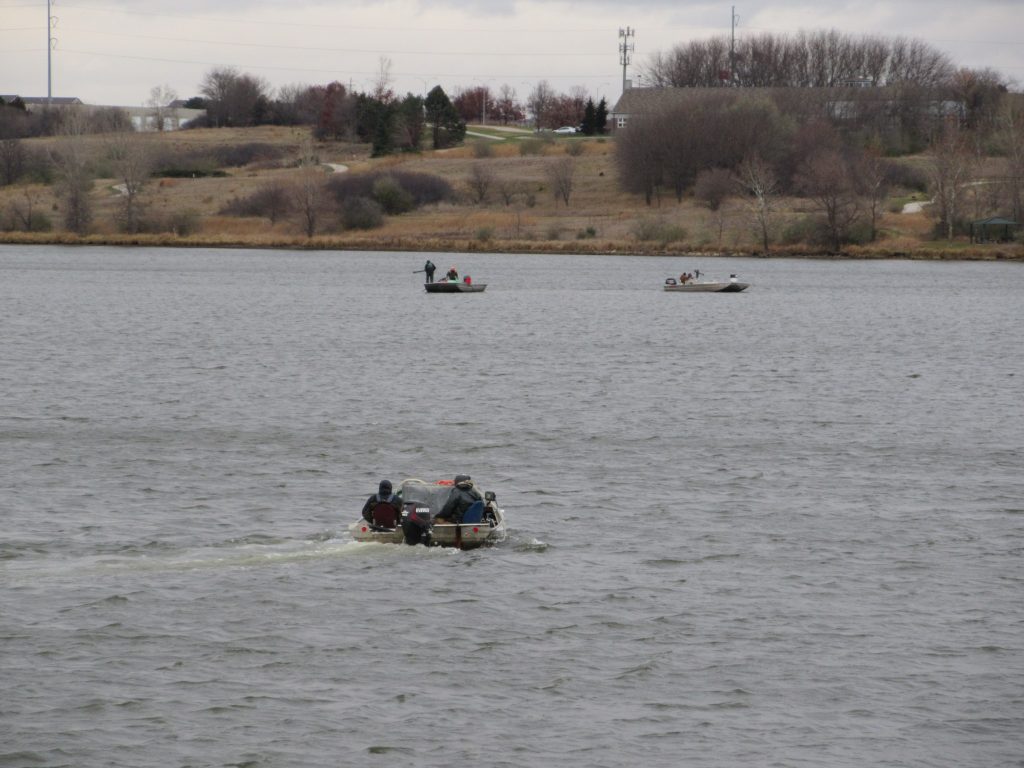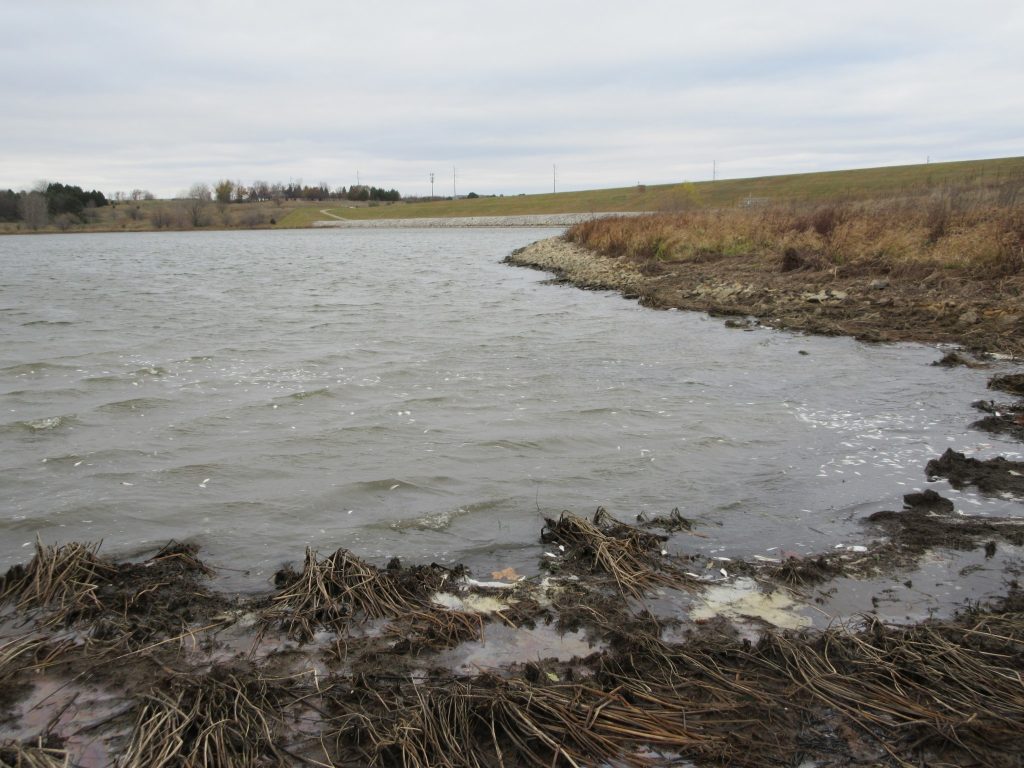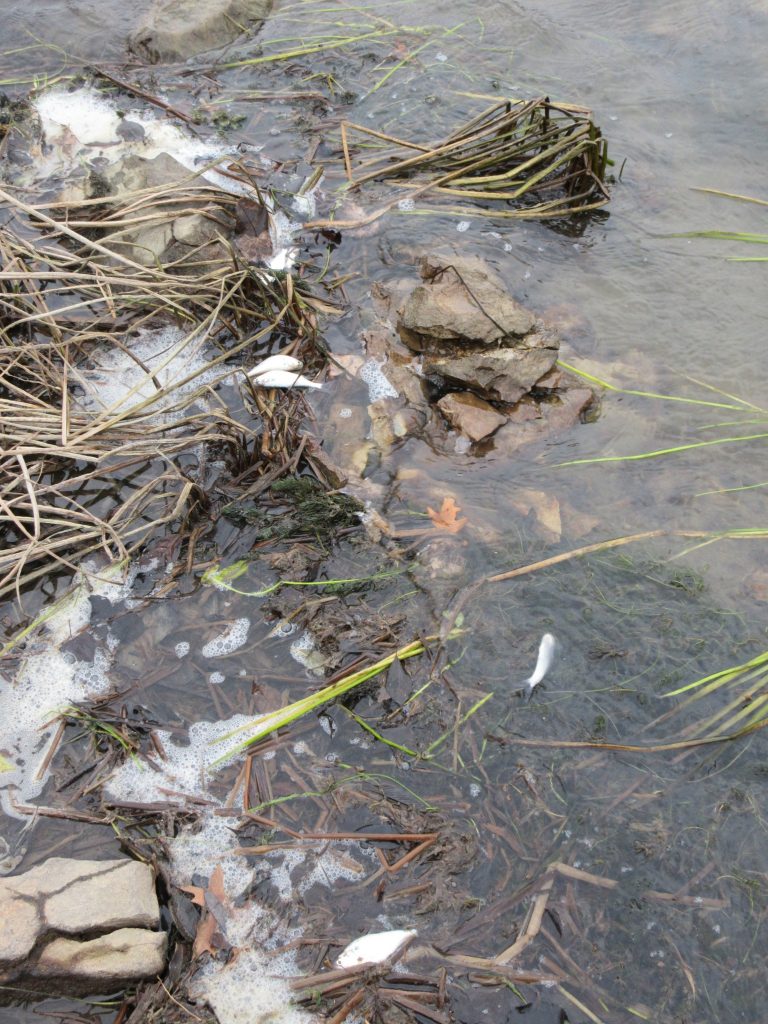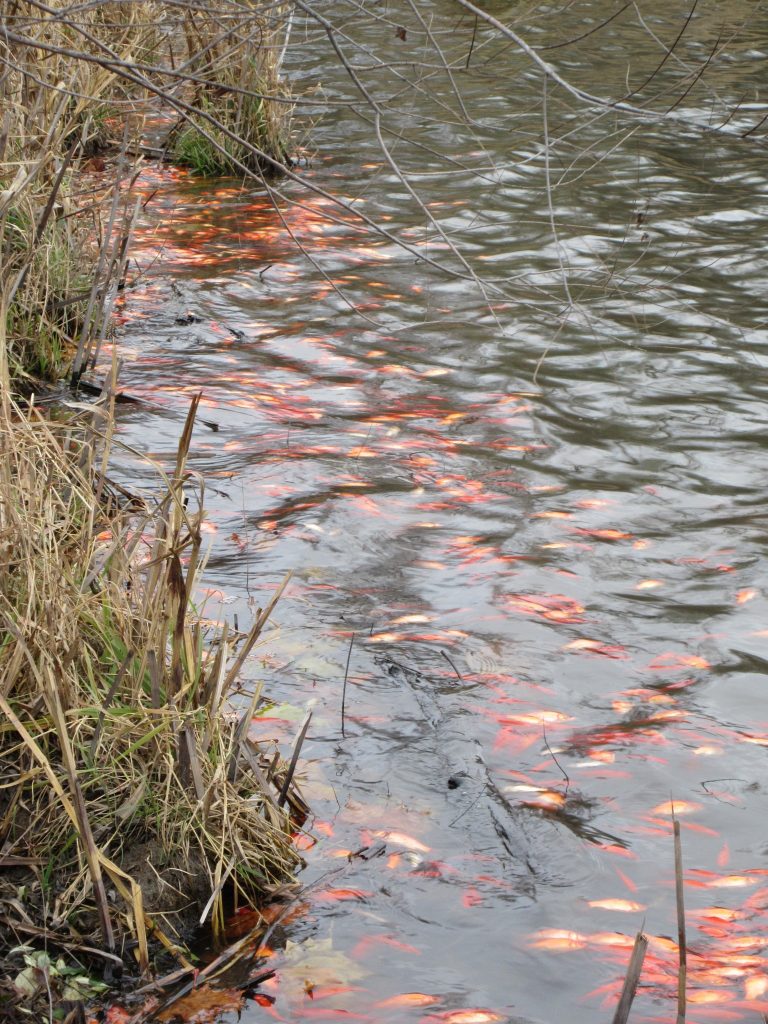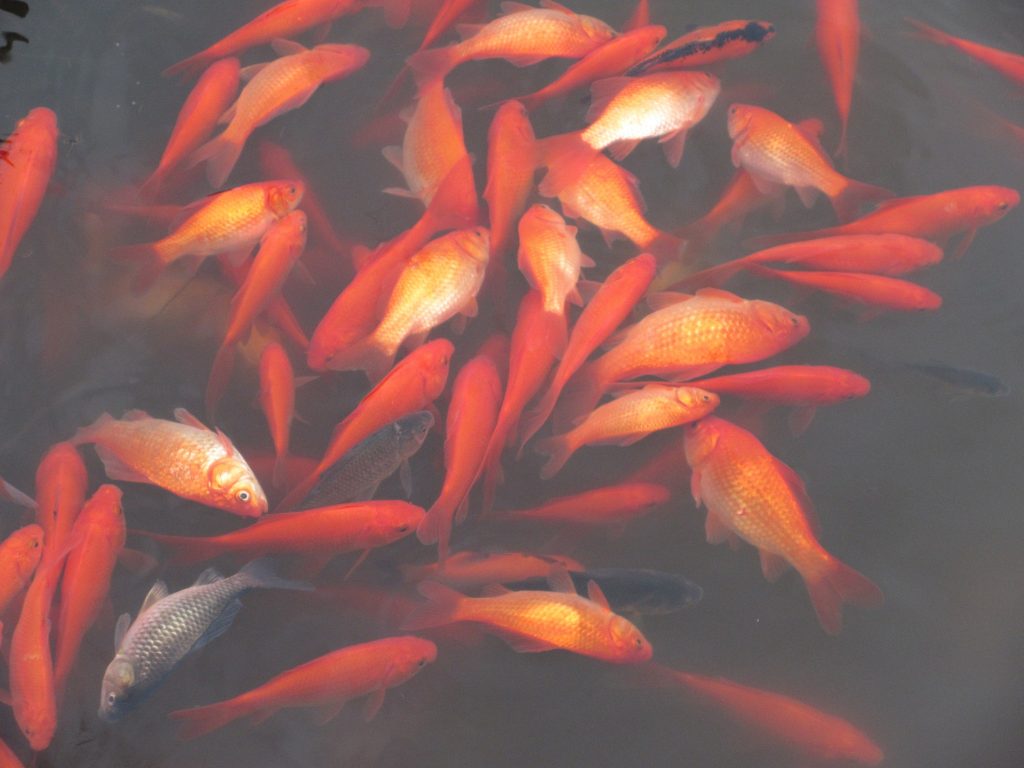I wanted to blog about this today, waited for the news release to be published, and now am finally getting around to it after answering questions about it all day long!
Gizzard shad targeted for removal from Wehrspann Lake
LINCOLN – The chemical rotenone has been applied at Omaha’s Wehrspann Lake in order to remove gizzard shad.
Gizzard shad are susceptible to a low dose of rotenone while fish such as largemouth bass, bluegill, channel catfish and crappie are less affected. Low dosages of rotenone are done at low water temperatures to increase its effectiveness on shad and lower impacts on nontarget species.
“Gizzard shad are targeted for removal because they are a detrimental species in small reservoirs such as Wehrspann,” said Daryl Bauer, fisheries outreach program manager with the Nebraska Game and Parks Commission. “With their high reproductive capability, gizzard shad compete for the same food used by young sport fish such as bluegill, crappie and largemouth bass. The presence of gizzard shad in a small reservoir often results in reduced natural recruitment, growth and body conditions of sport fish.”
Rotenone, derived from the roots of plants that grow in South America, inhibits the uptake of oxygen at the cellular level. It only affects gill-breathing organisms.
Next spring, additional 4-inch largemouth bass will be stocked in Wehrspann.
“Those small bass should have good survival once the gizzard shad have been removed, and they will provide extra predation on any remaining shad,” Bauer said. “Anglers can expect to have good fishing at Wehrspann next spring and an overall improved fishery in the future.”
I was out to Wehrspann yesterday and took some pictures of our field biologists getting this work done. Thanks guys, I know how cold and miserable it was on the water yesterday. I took some pictures, let me show a few and expand a little. . . .
Here is a good photo of the crews motoring around applying rotenone in the main reservoir area.
The latest GPS, depth-finder and mapping technology is very useful for doing this work. Volumes of water to be treated can be determined very accurately and then transects can be run to make sure the application is done as evenly as possible. Some boats apply rotenone on the surface, some pump the chemical deeper.
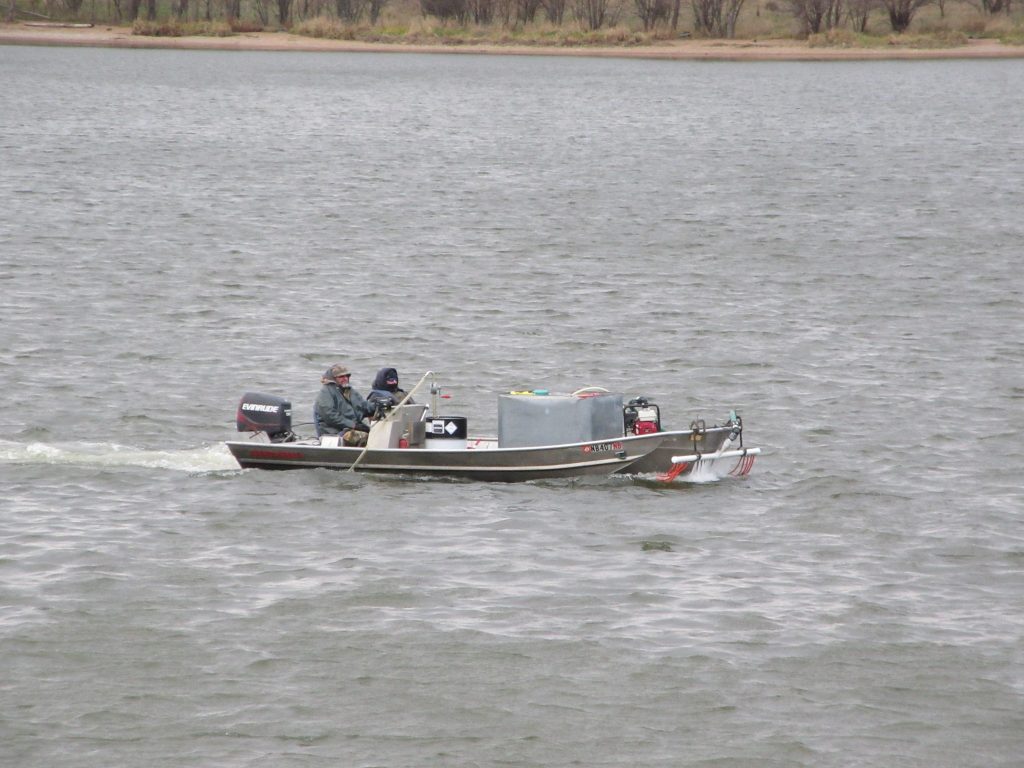
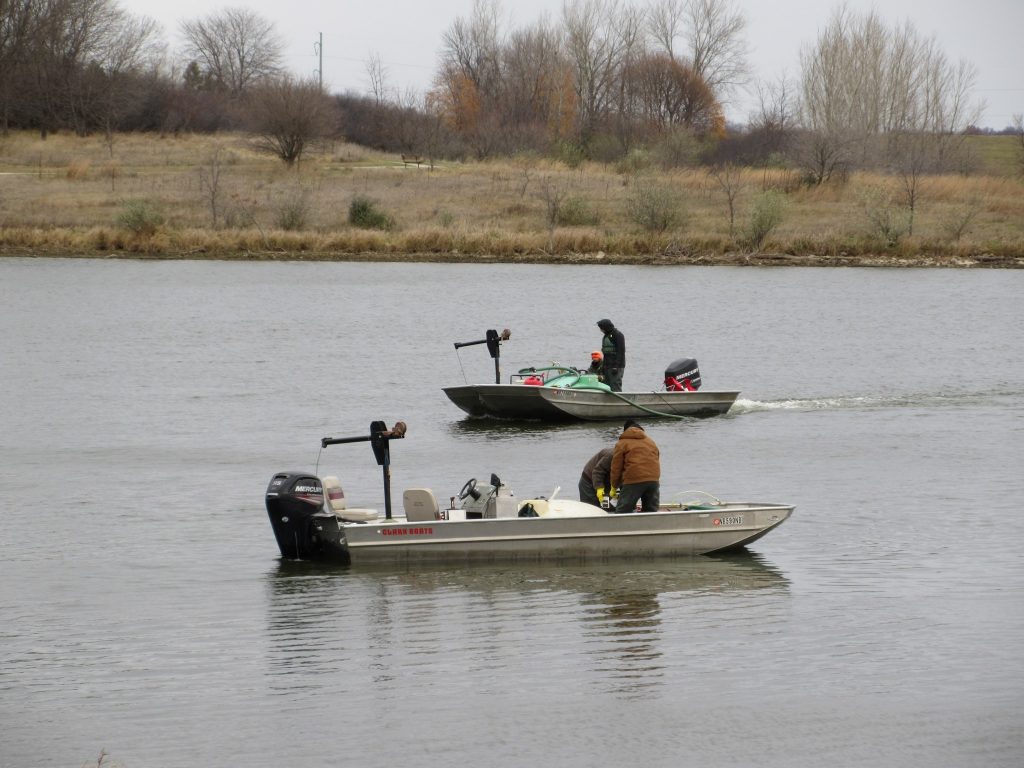
With a low-dose rotenone treatment it is very important to get the appropriate distribution of the chemical. The big bulk tanks on the boats are used to dilute the chemical so it can be applied as evenly as possible.
If you want some background on the chemical rotenone, look back to this old blog post, Lake Yankton Renovation. The renovation at Lake Yankton was different in that the dosage of rotenone applied there was enough to eliminate all fish, but the information on rotenone is relevant. At Wehrspann a lower dosage of rotenone was applied. Different species of fish have different sensitivities to rotenone, so by applying a lower dose, species like gizzard shad can be selectively removed while minimizing the mortality of other, more-desirable species. Gizzard shad are so susceptible to rotenone that they start to die when they see a barrel of it unloaded on the boat ramp.
By the time I left Wehrspann yesterday afternoon, dead shad were already piling up on wind-blown shorelines.
Most of the gizzard shad were small, young-of-the-year (YOY) fish, but I did see some larger, approximately 16-inch adults as well.
In small- to medium-size reservoirs where it is important to produce quality bluegill, crappie and largemouth bass fishing, “SHAD ARE BAD”! Yes, gizzard shad are an excellent bait fish for a variety of predatory sport fish in large reservoirs, but in smaller waters the shad compete with small sport fish for food resources. Gizzard shad are very prolific and an abundance of gizzard shad in a smaller body of water results in too little food available for bluegills, crappies and even small largemouth bass. We have had excellent success doing low-dose rotenone treatments on waters such as Louisville #2 and Pawnee Reservoir (Pawnee Renovation, Pawnee Renovation Revisited). On those waters, in a relatively short period of time, panfish populations as well as bass and other species have responded very favorably with increased growth rates, which results in more bigger fish, and of course that means better fishing! We expect the same results at Wehrspann in the coming years.
The low-dose treatment of rotenone done at Wehrspann will be most toxic to gizzard shad. Now listen to me, listen close. . . . I am NOT saying that there will be no other fish that succumb to this treatment. There will be. By yesterday afternoon I could see some dead bluegills and crappies, most very small, some dead catfish and yes, some dead walleyes and largemouth bass. In the coming days I am sure there will be a lot more of those, and some of those desirable sport fish will be large. But, I can guarantee BY FAR there will be way more dead gizzard shad. By doing this low-dose rotenone treatment this late in the fall, when the water is this cold, gizzard shad are even more susceptible to the low dosage of rotenone.
Let me say more about the non-target sport fish that will wash up on Wehrspann shorelines in the coming days. Believe me, I hate to see one dead walleye or blue catfish, especially if they are big fish. I think the same thing that every other angler thinks when seeing those fish dead, “Wish I coulda caught that one!” But, that will be a small sacrifice to be made for improved fishing in the coming years. Fisheries management is done at the population level, not at the individual level. By doing something as drastic as trying to eliminate the gizzard shad population, we can improve the conditions for every other species of fish in Wehrspann. The loss of a few individual sport fish, even if they are big walleyes, bass or catfish is unfortunate, but a small part of the long-term picture.
Beside that, let me add that we often do some salvage efforts to try to save some of the desirable fish before doing a treatment like this. Now, let me say this about those “salvage” efforts: First you can never save ’em all, and even with nets and electrofishing gear we can salvage only a fraction of the population. From a population management perspective, salvage efforts before rotenone treatments are not worth the time and effort. But, from a public relations perspective we make the effort and we did at Wehrspann the past couple of weeks; 170 adult walleyes were salvaged from Wehrspann and taken to nearby Zorinsky Lake in Omaha.
One other “side story” to tell you about. . . . There is a small pond on the south side of Wehrspann. As I recall, when Wehrspann was constructed that small dam was built to control runoff and sedimentation from that drainage on the south side. Well, that drains into Wehrspann and it was known that there were certain undesirable fish dominating that pond, so rotenone was applied there too. Here is what it killed.
You might be surprised at how many Nebraska fisheries have goldfish populations–populations that originated from folks illegally releasing their “innocent” little pets into local waters after they outgrew their aquaria or the owners tired of them. Maybe the little pond on the south side of Wehrspann will be able to produce some quality fishing itself now that the goldfish are gone?
I know some of this seems counter-intuitive–fish biologists intentionally killing fish. But, I can tell you that rotenone renovations in one form or another have been a very effective and important fisheries management tool for a long, long time. There is a cost, but the benefits will be far greater. We have had excellent success with low-dose rotenone treatments on other Nebraska waters and we are confident that the fish populations and fishing at Wehrspann Reservoir will benefit as well. Yes, there will be some short-term sacrifice, but I am betting in a short time I will be blogging about how well the Wehrspann fishery has responded.
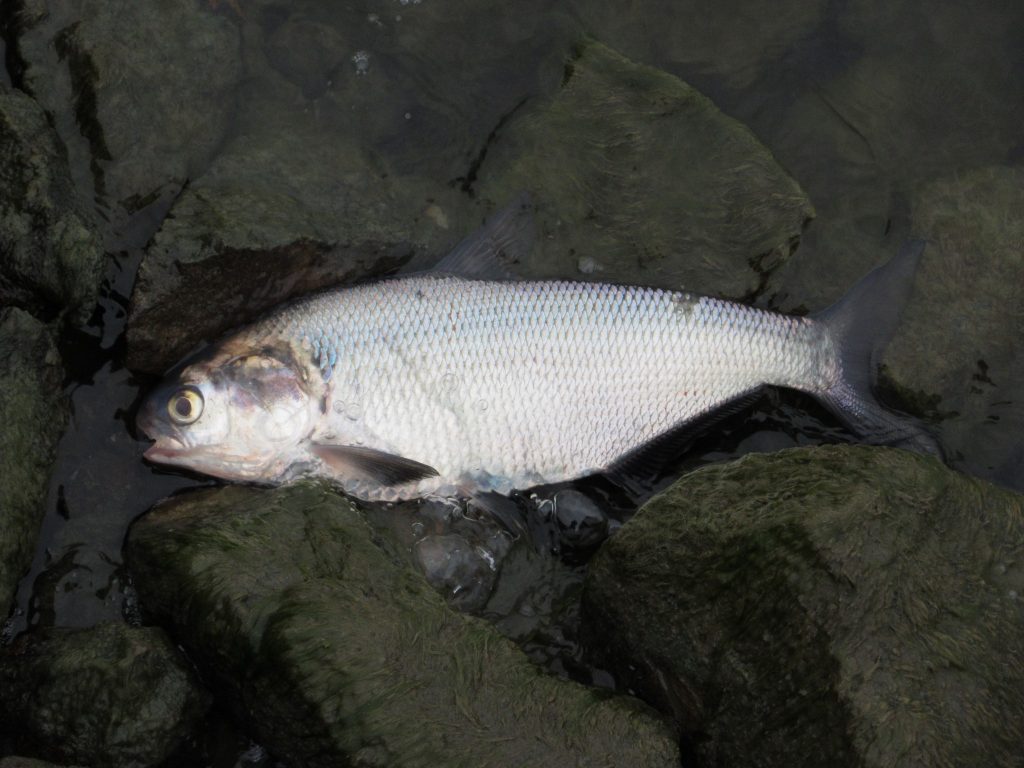
The post Gizzard Shad Removal from Wehrspann Reservoir appeared first on NEBRASKALand Magazine.


